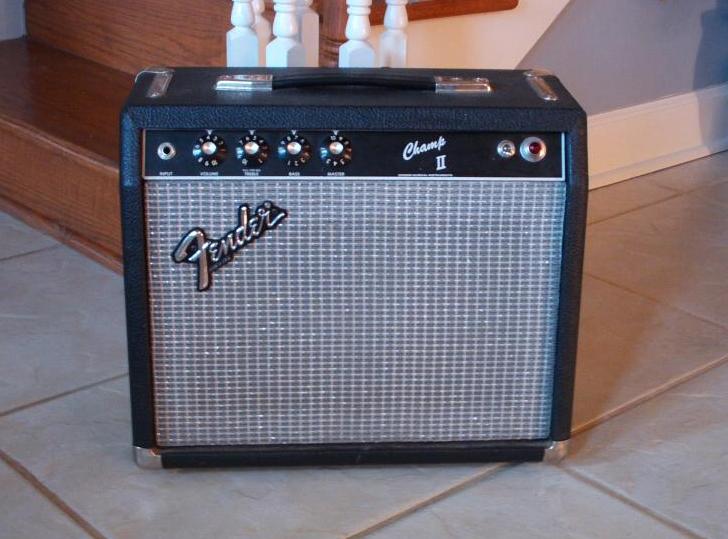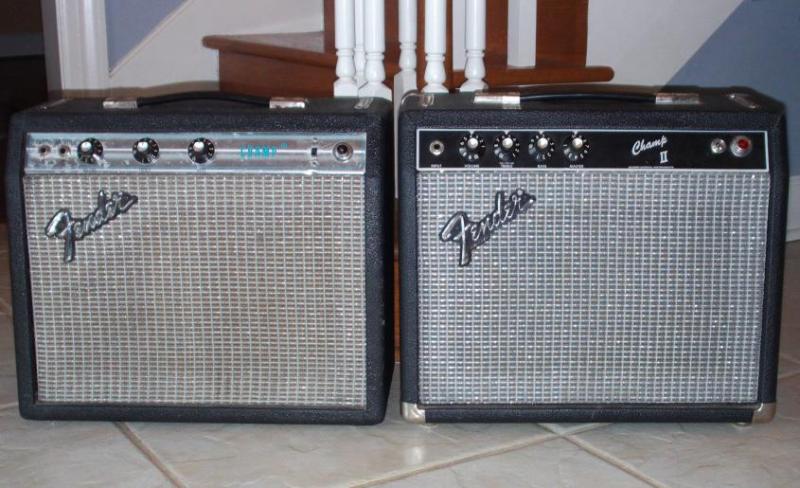The Fender Champ II - one Rare Bird!

Ya all know me well enough by now to know that I’m a big fan of vintage Fender amps. Primarily, I like the tweed and blackface era amps ... they rock, and in their day, no other amp could touch them in performance, quality and value. However, things really began to change at fender in the late 1970’s. The CBS bean-counters had cut corners again and again, and basically ran the Fender name straight down into the mud. Right about that time, a fellow named Randall Smith was really shaking things up with his new Mesa-Boogie amps, which began life as souped-up Fender Princeton Amps. Basically, Boogies were cool, Fenders were not. If fender was to survive, they had to do something, and they had to do it quick. As it turns out, Smith was far from being the only guy out there becoming famous for hot-rodding old Fender amps; another guy by the name of Paul Rivera was also making a name for himself by tinkering under the hood of some vintage Fender amps and turning them into high-gain hot-rods. In one of the few good decisions Fender made during that period in time, they hired Rivera and gave him the green-light to revamp the amp line "damn it, make them keep up with the boogies"! The first model to come out as a result is the subject of this blog, the Champ II. It was only produced for about one year (1982), making it among the rarest of all Fender amps. Ya ready to dig in, well then...
read on!
As you can see in this picture, my Champ II is almost exactly the same size as my 70’s silver-face Champ; but man, oh man are they different under the hood. The original Champ had remained virtually unchanged from tweed days all the way up to the latest silver-face models; the Rivera Champ II was something totally different. The Champ sported a single 6V6 operating in true class A mode, producing about 7 watts through an 8-inch speaker. The Champ II has 2 6V6’s in push-pull producing about 18 watts through a ten-inch speaker, and has an extra pair of 12AX7 triode gain stages in the pre-amp section. In other words, this was akin to a Princeton or Deluxe in the whoop-ass department, only with a little something extra in the front-end. This was that tiny little amp that you carried into a rehearsal to laughs and mockery, but by the end of the rehearsal everybody was gathered around reverently asking about it. Oh, and get this, because the Champ II is made of good-old finger-jointed pine, it actually weighs LESS than my 70’s silver face chip-board cabineted Champ (with the stock speakers anyway). Finally ... Fender had come out with a cool new design!
The Champ II sports a simple bass-treble tone stack in vintage fender fashion and pre and master volume controls. It’s that later feature that was all the rave of the day; you could crank up the input gain and get some good 12AX7 overload, whilst keeping the master wherever practicality dictated. What does a Champ II sound like? Well, that’s a bit of a loaded question. With the master wide open and the input gain below about 5, it sounds very much like a Princeton. However, with that extra gain, it could really put out the sustain (as it was called in the day), plus, it was armed with a new secret weapon. In tiny lettering under the treble control on the Champ 2 are the words "pull for mid boost". With this control engaged, it no longer sounds at all like a Princeton, now it sounds like a little JTM 45; gone is the smooth glassy top end, replaced with throaty (yet tasty) snarl.
All in all, the Champ II turned out to be a very cool amp, and the little buggers are now becoming highly sought after. The Rivera-era tube amps of the 1980’s were the last of the hand-wired Fender amps based on eyelet/turret boards. They sound good, are reliable, and are easy to work on or modify, just like what you would expect from a classic Fender tube amp! After only a year, the Champ II was replaced by the Super-Champ, which was basically the same amp only with foot-switchable reverb and gain boost. I’ve heard several Super-Champs side-by-side with my own personal Champ II, and I can tell you that the Champ II sounds better, probably because of the less complex circuitry ... especially the complicated switching and accompanying LED indicators (powered by the filament tap of the input tranny).
One last word on the Champ II and then I’m shuttin’ up. I currently have mine loaded with a WGS G10A, and baby, I gotta tell ya, what a difference that speaker makes in this amp. With the G10, that little bugger can keep up with a drummer on a club stage. Is it the ultimate pint-sized amp ... maybe.
See ya all next time around -Vaughn-
Oh, and here is a great interview where Rivera talks about his days at Fender, enjoy!
email vaughn
About Vaughn Skow